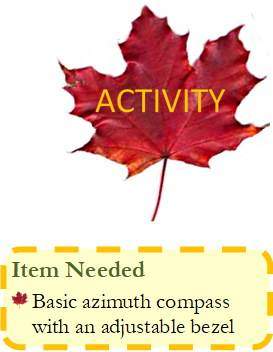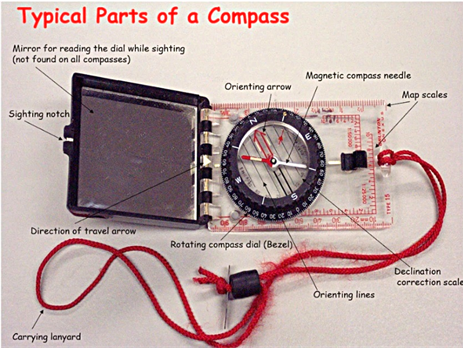Woods Wise Wire
The Maine Forest Service plans to begin distributing the second edition of its popular publication, The Woods in Your Backyard by late summer 2020. The book was first published in 1999 and was well received by family woodland owners, educators, and the public. To help people enjoy the Maine woods and the outdoors in general, the Maine Forest Service is releasing several activities from the book in electronic format this spring. The third and fourth activities to be released, Using a Compass & The Three-Legged Compass Walk, are great ways get out and enjoy the beauty of your property. The next activity is scheduled for release in about two weeks. Stay tuned and stay safe.

While a GPS app on your phone can be a very useful tool, you should also learn to use a compass in case your battery fails or phone malfunctions. Plus, navigating with a compass is just plain fun!
For this activity, you will need a basic compass with an adjustable bezel, a notepad, and a pencil. Silva, Brunton and Suunto are all recognized brands that can be easily be found online. An azimuth compass is recommended for this activity because it is the easiest and most intuitive to operate. The dial (or bezel) on an azimuth compass is divided into 360 degrees and north is both 0o and 360o.
|
Examine your compass and be able to identify the following parts:
- The magnetic needle is jiggly and moves around inside the dial (or bezel). The end that points North is usually red, and the end that points South is usually white. The degrees, which range from 0 to 360 on an azimuth compass, are located on the bezel.
- The direction of travel arrow may be long and skinny or may be just a triangle. This arrow is printed on the baseplate and is the only one on the compass that doesn’t move. It may be obvious or difficult to find. Make sure you can find yours.
- The orienting arrow is the larger arrow on the rotating bezel. It often appears in the form of an outline.
In this activity, you will learn to use a compass to navigate in a predetermined direction, stay on course towards a destination, and return to your starting point. This activity is designed to be completed with an azimuth compass.
30 minutes or less.
- Choose some place you will recognize when you come back, such as a bush or mark on the ground. Hold the compass flat in the palm of your hand with the direction of travel arrow pointing directly away from your body. You will always use the compass in this position. Don’t rotate the compass while you are using it!
- Hold your arm out straight and point the direction of travel arrow to some recognizable landmark in the distance—maybe a large pine tree. You don’t want something located in your backyard, that’s too close. Turn your body, not your compass! Make sure your palm (and compass) stay level.
- With the direction of travel arrow pointed at the landmark (pine tree), rotate the bezel until the orienting arrow is aligned with the red end of the magnetic needle. You can remember which end you need to align with the saying “put the red in the shed.”
- Read the azimuth off the bezel where it coincides with the direction of travel arrow and write it on your notepad.
- Now walk to your landmark (the large pine) and step around it. Hold your compass out in front of you and turn your whole body (not the compass or your arm) until the magnetic needle lines up with the orienting arrow again. Look ahead along the direction of travel arrow and find another landmark that falls on this line. You must keep the magnetic needle centered within the orienting arrow while sighting on the next landmark. This is how you travel in a straight line using a compass.
- To return to your starting point, stand in front of the large pine and turn your bezel 180° from the direction you were traveling. You may need to use your notebook to do some simple math. If your initial azimuth (x) is less than 180o, the math will be (x + 180). You will add 180 to your initial azimuth. In contrast, you must subtract 180 from your initial azimuth (x) when x is greater than 180o. In this case, the math is (x – 180). As you can see, your answer must always fall between 0° and 360°.
Suppose you get turned around while you are hiking or hunting in the woods. Even knowing the basics of how to use a compass will help you choose a basic direction of travel and stick to it. If you recognize a distant landmark, point your direction of travel arrow at it, put “red in the shed,” and sight on a closer landmark on the same azimuth. Walk to the closer landmark, step around it, and put the “red in the shed” again to find another landmark. Repeating these steps you will leapfrog to your destination.
|
The three-legged compass walk will help you get even more comfortable with your compass. It works best in a large field or parking lot. In addition, it’s important to walk with your normal stride to form a triangle with equal sides.
As in “Backyard Family Activity #4: Using a Compass,” you will need a basic azimuth compass with an adjustable bezel.
|
|
 |
Review the “Getting Ready” section for Using a Compass activity above before starting this activity.
In this activity, you will learn to travel through an area using a triangle-shaped route. The route will take you back to your starting point.
30 minutes or less.
- Choose a starting point. Turn the bezel of your compass so that 40° is lined up with your direction of travel arrow. Then turn your body with the compass extended in front of you until the red end of the magnetic needle is in the orienting arrow (“red in the shed”). Pick a certain number of steps to walk (25, 50 or 100), and walk across the field or parking lot keeping the needle inside the arrow. You won’t be looking at a landmark but at your compass the whole time.
- Add 120° to your original 40° to get 160°. Turn your bezel so that 160° is lined up with the direction of travel arrow. Turn slowly and put the magnetic needle inside the orienting arrow. Then walk in that direction the same number of steps you walked the first time.
- Add another 120° to your 160° to get 280° and follow the same procedure as in Step 2. Once you have traveled the same distance as before, you will be back at your starting point.
You just traveled a route that formed an equilateral triangle. You can make this activity more challenging by placing a quarter between your feet when you start. Then try to end your walk in the exact spot that you began. Try the activity several times to become more comfortable with your compass. Once you’ve mastered this activity, consider trying a four-legged walk (square-shaped route) by turning the compass bezel 90° at each corner.
| 




